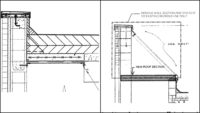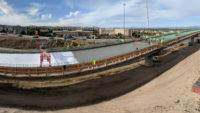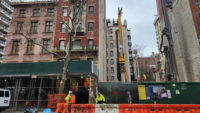The condominium board at a 1,396-ft-tall residential tower on New York City’s Billionaires’ Row has sued the building’s developers, claiming to have identified more than 1,500 construction and design defects in common areas alone.
Residents of 432 Park Avenue in Manhattan are living with serviceability issues like “horrible and obtrusive noise and vibrations” and may face more serious problems as well, the lawsuit filed in New York Supreme Court on Sept. 23 claims. The alleged defects, which the suit states were identified by SBI Consultants on behalf of a group of residents, don't conform with construction documents or don’t conform with industry standards. There are also alleged code violations or “life safety issues,” in the suit.
The plaintiffs are seeking more than $250 million from the building’s sponsor, 56th and Park (NY) Owner LLC—an entity used by New York City developers to start condos and run their boards until most of a building’s units have been sold—plus seven employees of developers CIM Group and Macklowe Properties, who have served on the condo board. The developers themselves are not named as defendants.
96-Story High-Rise
The 96-story high-rise was the tallest residential building in the Western Hemisphere when it was completed in 2015 and remains one of New York’s tallest buildings. The units were marketed as luxury condos with “the finest quality design, construction, amenities, safety and security,” the lawsuit states. Condo prices started at $7 million. The 8,255-sq-ft penthouse on the 96th floor, with six bedrooms and eight bathrooms, is currently listed for $169 million.
“Far from the ultra-luxury spaces that they were promised, however, unit owners were sold a building plagued by breakdowns and failures that have endangered and inconvenienced residents, guests and workers, and repeatedly been the subject of highly critical accounts in the press and social media,” the lawsuit states.
In a statement responding to the lawsuit, 56th and Park (NY) Owner LLC said that “432 Park delivers the finest level of service, world-class amenities and state-of-the-art technology and is an iconic addition to the New York skyline.” The developers declined to comment.
“Virtually all new construction has maintenance and close-out items during the building’s initial period of occupancy,” the sponsor says. The “sponsor has been and remains committed to working collaboratively with the [homeowners' association] to resolve these matters.
The SBI report identified defects in the building’s structural system, its envelope, its mechanical, electrical and plumbing systems, its architecture and interiors and its elevator and vertical systems, the complaint states. The commercial unit owners at the base of the building also hired SBI to examine defects in their section. The consultant estimated repairs for some of the issues would cost about $5 million.
Elevators programmed to slow down under high winds have sometimes shut down entirely, trapping residents inside for hours and leaving others unable to access their homes, the complaint states. Apartments are “plagued” by noise and the trash chute sounds “like a bomb.” Cracks have formed in ceilings and walls, and there are gaps around some light fixtures, the residents add.
There have also been problems with water leaks, the suit states. One leak allegedly caused by “poor plumbing installation” in November 2018 halted two of the four residential elevators for weeks and caused water damage to 35 units, plus common areas.
Seismic Dampers
The Rafael Viñoly Architects PC design for the tall, skinny tower with a 1:15 slenderness ratio required some engineering solutions to reduce sway and acceleration, which are typically serviceability issues, rather than structural safety ones. Five open levels, each spaced twelve floors apart, allow wind to pass through the building. Ontario-based wind engineer RWDI also designed seismic dampers on top with a combined mass of about 1,300 tons aimed at reducing acceleration.
The construction process also posed some unusual challenges. The white cement used for the exterior is more difficult to mix than gray cement, and it had to be pumped nearly 1,400 ft to the top of the structure. The 2.5-in.-dia, 97-ksi rebar necessitated a template to ensure accurate positioning of 15.5-ft-tall column modules.
When some 432 Park residents tried to get repairs made, the suit alleges the sponsor denied responsibility and the condo board, which was under sponsor control until early 2021, delayed work or used cheap, flimsy repairs.
“As unit owners began to move in and occupy their units, they soon discovered that, although the building was billed as the pinnacle of luxury, the building’s construction severely missed that mark,” the complaint states. “Not only is the building’s construction defective under prevailing luxury standards, but it also presents significant safety issues.”
The sponsor also refused to provide as-built drawings or supervise contractors making repairs, the complaint alleges. In one case in July 2021, a worker dealing with a water leak drilled through concrete into the building’s electrical wiring, causing an arc flash explosion and disabling air conditioning for many of the residents. The emergency repairs that followed the incident cost more than $1.5 million.
In its statement, the sponsor added that it has honored “each and every commitment and term contained in the 432 Park Offering Plan and Declaration,” and accused the HOA of restricting access to the property, delaying certain work.
“In addition, the HOA and certain vocal residents misunderstand [the] sponsor’s obligations,” the sponsor said in the statement. “This includes demanding modifications to the building and its operations that, while preferred by the HOA, are clearly not the responsibility of sponsor. Although we are saddened, if in fact, these misperceptions have precipitated litigation, [the] sponsor is confident any legal process will confirm its position.”






Post a comment to this article
Report Abusive Comment